in many ways, the nineties can be viewed upon as the last decade when fashion was still a member's only club and still held intrigue amongst those who were not part of it's elitist circle. the advent of the communication age and the internet revolution has democratized fashion and made it more easily accessible for those who although cannot afford it, is able to give them an insiders look on a business which at one point in time protected its world and ideas with the most heightened sense of security.
it might be hard to imagine that it wasn't so long ago that the idea of camera men inside a fashion show was enough to create panic of gargantuan proportions. in those days, designers protected their ideas and its integrity fervently. they were weary of being copied because back then fashion houses would sell their designs to mass market retailers to be able to be duplicated for a price. nowadays, one only has to turn on the computer a day after a fashion show and be able to view the whole collection on-line, video streaming included. only to see an interpretation of it two months later at high street retailers front display windows for a fraction of the price.
the mood of urgency in fashion right now to produce the next newest thing has become a race that although sometimes is still able to produce collections with an actual impact outside of fashion, usually results in, for a lack of a better word, uninspired. save for a few designers of course who are more interested in developing their respected houses rather than looking for the seasonal cash cows, the lack of a strong, coherent idea across the globe to produce a look that defines the two thousands is a testament that although this decade has sold more luxury hand bags and accessories than previous times, it fails to assert a personality.
in the nineties, there were two distinct aesthetics that defined the decade. two distinct schools of fashion that found favor with the women of those times. one who preferred beautiful simplicity through rigor and technique, and the woman who used fashion to realize the fantastical.

calvin klein-spring/summer 1995
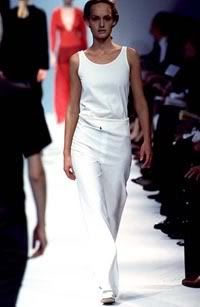
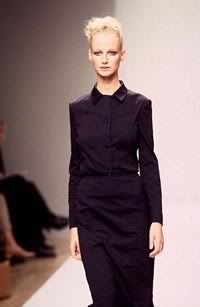

jil sander-spring/summer 1997, prada-spring/summer 1997, helmut lang-fall/winter 1996
the minimalist movement in fashion gained momentum during the mid-nineties. after such an extravagant display of opulence during the second golden age of couture in the eighties and followed by the overt excessiveness of gianni versace in the early nineties, the fashion pendulum had no where else to go but the direct opposite of it. after the grunge explosion of 93, the new mood of fashion was headed towards a more reality based sensibility. after everything that was piled on to fashion, the need to strip it down to its most minimal and the "less is more" mantra became a more predominant theme.
perhaps the coming of a new millennium and a sense of exhaustion after a sixties and seventies revival, designers were looking for a real sense of modernity. and one of the strongest themes of modernism in art has been a minimal aesthetic. championed by the likes of calvin klein and miuccia prada, both designers presented a collection during the fall/winter 1994 shows filled with knee length hemlines, an extremely muted palette of neutral colours, and a little sense of austerity and maturity. mind you at this time most of the collections were presenting the mini skirt, cropped tops, and a more playful and frivolous feel, the collection prada and klein showed would eventually change the course of fashion and bring the minimalist idea forward.
amongst those designers whose profiles were suddenly at the forefront were the german born jil sander who has been designing with the minimalist aesthetic since starting her eponymous house in 1968 but only really gained popularity during the nineties. and then there was helmut lang, the austrian who was able to combine minimalism with utilitarian details to create a look that matched the harder edge of the nineties with luxury and by doing so became one of the biggest influences to the new generation of designers that heralded the twenty first century.
the minimalist aesthetic was the one theme that was present in new york, milan, and paris. each major fashion capital had designers creating under the minimalist umbrella. although there were subtle changes across the ponds, the spirit of minimalism was obviously pronounced throughout. it influenced new designers and at times even coerced older designers to adapt to its philosophies.
minimalism has been the defining look of the nineties. the ideas presented by minimalism influenced everything in fashion. from advertising, presentation, and even the models, the minimalist idea was the major theme.
however influential minimalism was, the atmosphere in the nineties was able to cradle two opposing aesthetic. one that was focused on purpose and sensibility, and another that explored ideas not confined in one theme, but harvested influences like an alchemist to produce creations that however overtly decorated and impractical, had a new modern spirit that separated it from any attachment to the eighties.

john galliano-spring/summer 1997
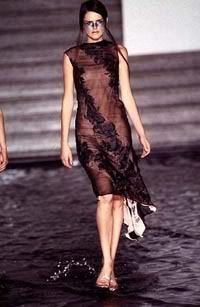
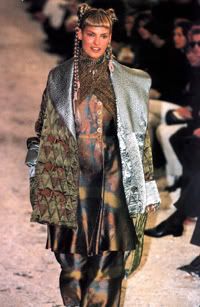
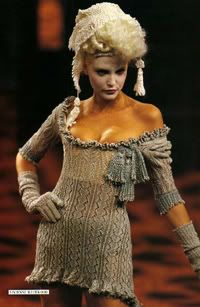
alexander mcqueen-spring/summer 1997, jean paul gaultier-fall/winter 1994, vivienne westwood-fall/winter 1995
as dominant as the minimalist ideology was at the time, there was a group of designers that provided a respite from the "bareness" that was so prevalent during the nineties.
leading this group of maverick designers were the british, most notable john galliano. galliano first gained notoriety after his graduate collection from central saint martins entitled "incroyables". inspired by the new romantic movement, the wave of japanese designers showing in paris, and the eccentric eighties london club scene populated with colourful characters such as the performance artist leigh bowery. even in the beginning, the fantasy element and the collision of exoticism and cultural references were apparent from the start.
in the nineties, galliano's romantic vision blossomed and started to gain influence. his theatrical runway presentation which merged fashion and performance filled with ambience and models playing characters became the hottest ticket in paris. in his sensitive hands he combined themes as disparate as masai, native america, the belle epoque, ancient egypt, flamenco, asia and the circus into a creative hodgepodge even with all the contrasting ingredients, became absolutely delicious amidst a sea of black and beiges and the utalitarian sensibility. it was his romanticism that eventually landed him the job as creative director for the illustrious house of christian dior in 1997. the sheer joy of galliano's collection balanced the sometimes overt seriousness in the minimalist attire. while galliano's collections celebrated the joy of life, his country man alexander mcqueen saw beauty in the darker side of things initially prompting shock and outrage from the public with his sentiments. he eventually won the crtics over by displaying his ability to also present collections of unapologetic beauty. more specifically his "water" collection of spring/summer 1997, and the "robot" collection a year later.
although galliano and mcqueen were relative new comers in the business, the old guard of the romantic movement, namely vivienne westwood and jean paul gaultier also flourished at this time. westwood who has been one of the most influential designers of the past twenty years asserted herself again as a creative force that was showing no sign of fatigue. just as she did when she invented the punk aesthetic, she continued to challenge perceptions of female beauty. this time borrowing techniques and philosophies from days gone by. at a time when everyone was so concentrated on the future, westwood, in true punk form broke away from the collective thought and looked at the past not as a revivalist, but as an archeologist searching for a truth.
like galliano, gaultier has always cross referenced multi-culturalism as a proverbial theme. the nineties saw him fusing traditional ethnic costumes with modern street fashion like the underground culture of tattooing and body modification to continue to make his work contemporary and relevant. not once losing the humor and french sophistication he built his reputation on.
as the nineties drew to a close and a new era of opulence was starting to emerge brought upon by the likes of tom ford at gucci, minimalism fell out of favor. while designers like calvin klein and jil sander were still staunch supporters of the movement, the popularity of ford and the new mood he brought captured the public's imagination. unlikely factors such as the before mentioned internet revolution, celebrity obsession, and the rise of urban superstars who regularly dropped luxury labels into their lyrics with their penchant for flashing their goods at any opportunity greatly added to the demand for luxury brands. and since one of the minimalist creed is to be subdued and personal, these new harbingers of "cool" instead chose the loudest and most elborate pieces to be noticed. influencing consumers to buy products identified with a celebrity.
the new romantics however managed to elevate their craft to the highest level of fashion. galliano, mcqueen, and gaultier all became creative directors at haute couture houses and westwood is still able to provoke controversy. most recently with her support for various causes such as the environment. what these designers did manage to do was to combine their romantic ideas with the purpose of minimalism. to look at galliano's work now and ten years ago its obvious to see that he now puts more regard to the wearability and function of the clothes, not just its show value. and now a new breed of designers like raf simons is again championing the minimalist ideology. proving that the ideas that stemmed from it will reverberate and continue to influence the designers of the future.

5 comments:
You should teach fashion history at the best school of fashion, whatever that is, probably the Antwerp's Royal Academy, really. Thanks for this post. :)
awww...thank you. that was very nice. all that knowledge i got from watching tim blanks for fifteen years. he's my idol. and you're my other idol. lol.
awww... that's putting me way UP there! thank YOU.
u know you're a big inspiration to me! your posts are really thoughtful and worked, you put a lot of time on them and good energy, that's so rare in the blogosphere, geeez :)
i love these love letters we write to each other... ^_+
the "water" collection is S/S 1997 ready-to-wear entitled "Bellmer La Poupee" after the study of automata and Hans Bellmer. "Robots" (with Shalom and Amiee Mullins) was not a year later...it was S/S 1999.
thanks for the correction anonymous. this is why firstview should be free again. that way i can properly date collections pre style.com and i don't look like a tool.
Post a Comment